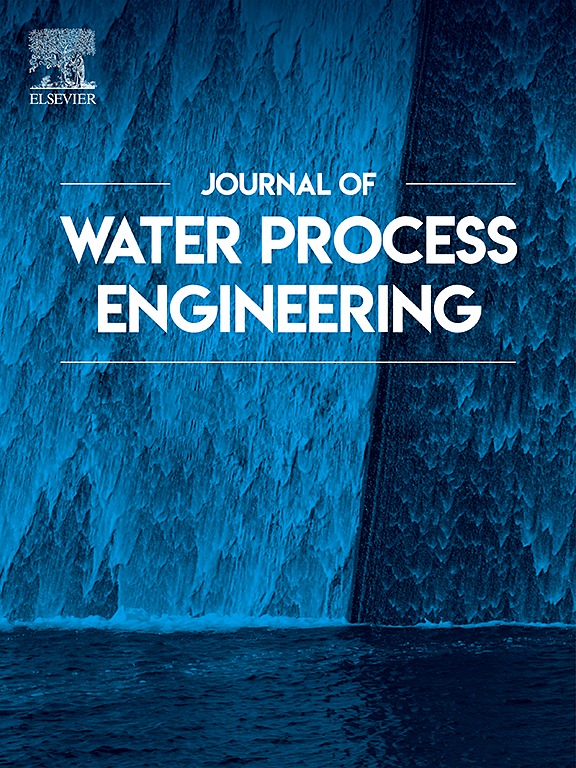Changing activated sludge activity: microbial responses to short-term vacuum conditions while municipal wastewater treatment
IF 6.3
2区 工程技术
Q1 ENGINEERING, CHEMICAL
引用次数: 0
Abstract
This study examines the impact of vacuum treatment on microbial activity in activated sludge during wastewater treatment. Vacuum treatment, applied at pressures from 500 to 30 hPa for 0.5 to 10 min, was combined with activated sludge processes to improve sludge degassing, sedimentation, and wastewater separation. Key microbial activities assessed included dehydrogenase activity, oxygen uptake rate, ammonia utilization, denitrification, and phosphorus release.
Results showed that reduced pressure generally inhibited dehydrogenase activity, oxygen uptake, and denitrification, with effects varying based on initial sludge activity. Nitrifiers experienced inhibition at lower pressures and shorter durations but showed stimulation at 30 hPa, though with variable results. Notably, polyphosphate-accumulating organisms consistently exhibited increased activity regardless of pressure, duration, or sludge conditions.
These findings highlight the potential of vacuum treatment to optimize specific bioprocesses, such as nitrogen removal and phosphorus recovery, while improving sludge sedimentation. However, the variability in results suggests the need for further research to refine vacuum treatment parameters for enhanced efficiency. This study underscores the role of controlled depressurization in selectively stimulating microbial functions, contributing to the development of more effective wastewater treatment strategies.
改变活性污泥活性:微生物对短期真空条件下城市污水处理的反应
本研究考察了真空处理对废水处理过程中活性污泥微生物活性的影响。真空处理,在500至30 hPa的压力下应用0.5至10分钟,与活性污泥工艺相结合,以改善污泥脱气,沉淀和废水分离。评估的关键微生物活性包括脱氢酶活性、吸氧速率、氨利用、反硝化和磷释放。结果表明,减压通常会抑制脱氢酶活性、吸氧和反硝化,其效果因污泥的初始活性而异。在较低的压力和较短的持续时间下,硝化器受到抑制,但在30 hPa时表现出刺激,尽管结果不同。值得注意的是,无论压力、持续时间或污泥条件如何,聚磷酸盐积累生物始终表现出增加的活性。这些发现强调了真空处理优化特定生物过程的潜力,如氮去除和磷回收,同时改善污泥沉降。然而,结果的可变性表明需要进一步研究以改进真空处理参数以提高效率。本研究强调了控制减压在选择性刺激微生物功能中的作用,有助于开发更有效的废水处理策略。
本文章由计算机程序翻译,如有差异,请以英文原文为准。
求助全文
约1分钟内获得全文
求助全文
来源期刊

Journal of water process engineering
Biochemistry, Genetics and Molecular Biology-Biotechnology
CiteScore
10.70
自引率
8.60%
发文量
846
审稿时长
24 days
期刊介绍:
The Journal of Water Process Engineering aims to publish refereed, high-quality research papers with significant novelty and impact in all areas of the engineering of water and wastewater processing . Papers on advanced and novel treatment processes and technologies are particularly welcome. The Journal considers papers in areas such as nanotechnology and biotechnology applications in water, novel oxidation and separation processes, membrane processes (except those for desalination) , catalytic processes for the removal of water contaminants, sustainable processes, water reuse and recycling, water use and wastewater minimization, integrated/hybrid technology, process modeling of water treatment and novel treatment processes. Submissions on the subject of adsorbents, including standard measurements of adsorption kinetics and equilibrium will only be considered if there is a genuine case for novelty and contribution, for example highly novel, sustainable adsorbents and their use: papers on activated carbon-type materials derived from natural matter, or surfactant-modified clays and related minerals, would not fulfil this criterion. The Journal particularly welcomes contributions involving environmentally, economically and socially sustainable technology for water treatment, including those which are energy-efficient, with minimal or no chemical consumption, and capable of water recycling and reuse that minimizes the direct disposal of wastewater to the aquatic environment. Papers that describe novel ideas for solving issues related to water quality and availability are also welcome, as are those that show the transfer of techniques from other disciplines. The Journal will consider papers dealing with processes for various water matrices including drinking water (except desalination), domestic, urban and industrial wastewaters, in addition to their residues. It is expected that the journal will be of particular relevance to chemical and process engineers working in the field. The Journal welcomes Full Text papers, Short Communications, State-of-the-Art Reviews and Letters to Editors and Case Studies
 求助内容:
求助内容: 应助结果提醒方式:
应助结果提醒方式:


